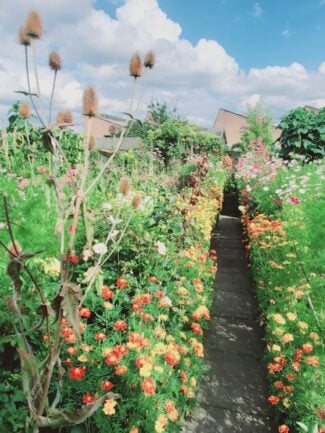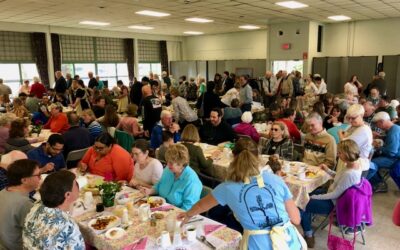Above: One of the Scottish “allotments” George visited during a visit in August. Photo by George Christie
By George Christie
Being a naturalist and a gardener, the places I visit when I go on vacation are sometimes a bit different. Case in point, my daughter lives in Scotland and on my first trip there a few years ago I thought we should go to the Isle of May. Why? Puffins of course, tens of thousands of puffins, along with several other types of oceanic bird species. Fortunately, my daughter saw no reason why puffins shouldn’t be on the list of “must sees” so off we went by train and bus and boat. Well off the beaten tourist paths of Scotland, the small boat that took us to the island for the day was still close to full of fellow puffiners. Fortune was with us. The puffins had been off to sea until the day before (it turns out puffins like to do things in groups) but had returned just in time for us to see them in their uncountable numbers.
So, it should come as no surprise that, on our last visit to Scotland, in August, when I found out one of her professors for her Ph.D had an allotment in Glasgow, I thought, well this is something I want to see. In Great Britain (Scotland, BTW, is what puts the “Great” in Britain) what we call community gardens are called allotments, a system of small gardens for urban dwellers. These were first created in the mid-1800s, as the landed gentry and industrialists realized the increasingly crowded conditions of the city meant the traditional small vegetable patches of the working class were disappearing.

Photo by George Christie
On a crisp August day, we joined Ewan at his allotment in New Victoria Gardens in Glasgow. The current 4.5-acre site was established in 1872 on private land for the use of the urban working class. The primary goal was vegetable production for family use, though flowers were an integral and delightful part of the mix from early on. We needn’t dwell too much on the past, except to note the gardens have had their ups and downs, ups when food was scarce (World War II) and downs when times were good (late ‘50s). The good news these days is allotments, like community gardens in the U.S., are highly sought after. The waiting time for one can be a year or more, and the gardens today are clearly thriving.
Why might this be so, and why am I traveling so far afield to talk about a type of gardening that has little to do with native plants? Because food security is essential for a sustainable future, and locally grown food is one of the simplest ways a person can counteract the damage done by large-scale, distant agriculture. In the U.S. today our produce travels an average of over 1,000 miles to get to our table, an absurdly long trip just to have flavorless tomatoes on nutritionally useless lettuce. Food production that reduces our reliance on ecosystem-destroying transportation will be a vital part of regenerating a livable world.
European allotments (they’re big in places like Holland as well) have been well studied, and the results clearly highlight their value. As a general rule, they produce more food per acre than factory farms and use fewer pesticides in doing so. Along the way, their sheer exuberant diversity of plants creates outstanding habitat for pollinators and other essential flora, fauna, and fungi. These small bits of life are typically overlooked, but are essential to maintaining a strong, functioning ecosystem. In an age of apocalyptic declines in populations of most insects, spiders and other small arthropods, anything that promotes their abundance and diversity is a real plus.
And promote diversity they do! Here is one full of beds of a wide variety of flowers, there is one full of rows of vegetables. Small pools dot the allotments and compost heaps provide homes for a myriad of creatures. Found wood creates fencing and sheds, found windows create greenhouses and cold frames. Each allotment is unique. Each allotment is expressive. Each allotment is a source of connection among plants, animals, and people. And any one of them is something any one of us with a bit of land can do right here in Rhode Island.

Photo by George Christie
Community gardens, like allotments, thrive best in urban areas, where people can walk to their garden and where access to fresh food is often curtailed by lack of space, absent stores, or higher prices. But there are good reasons to create more “community” gardens at our homes. For some reason we’ve decided the barren lawn cemetery (those grub and crabgrass treatments kill a lot more than grubs and crabgrass) edged by struggling shrubs from distant continents is the “Ideal” front yard. These post-human wastelands are so attractive to us that we never use then for anything, but count ourselves rich for owning them, even as we pour money into the upkeep of their sterility, lamenting their absent butterflies by day and missing our childhood fireflies by night. How much more interesting would all our neighborhoods be if each of us dedicated a six-foot-wide strip of yard facing the street to allotment-type gardens?!
I think we’d learn about both our environment and our neighbors when, as a group, we watch a butterfly dance from yard to yard. The potential for so much more exists, easy to see in the allotments of New Victoria Gardens in Glasgow, easy to see here, if only we so choose.
George Christie, who studied entomology and landscape architecture, has worked in mosquito control, environmental education and garden design and plant sales. He currently works for the Rhode Island Natural History Survey managing their rare species database.






 Subscribe
Subscribe
Delightful and insightful as usual, George!
Hope to discuss Diptera (flies) surveys with you for 2024.
For anyone with further interest in “allotments” in Europe, my book provides a good inroad in the topic (Nilsen, Micheline. The Working Man’s Green Space: Allotment Gardens in England, France, and Germany, 1870-1919. Charlottesville: University of Virginia Press, 2014).
Well said, George! Giving us lots to think about over the winter…the best time to start planning a garden 🙂
Was just reading more today about sub-lethal effects of herbicides on predatory ground beetles in agricultural settings. They don’t die, but they fail to reproduce. Glad you’re working to find a better path!
That allotment garden is beautiful! Thanks for the inspiration, George.
And thank you for your kind affirmations yesterday. Looking forward to greener tomorrows.